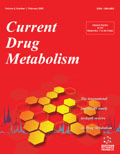To find the most relevant journal, please insert appropriate keyword to facilitate search.
Search Results: CDM
Current Drug Metabolism
ISSN: 1389-2002 (Print)
eISSN: 1875-5453 (Online)
Impact Factor :
2.1
CiteScore:
4.3
More specifically, in vitro and in vivo drug metabolism of phase I and phase II enzymes or metabolic pathways; drug-drug interactions and enzyme kinetics; pharmacokinetics, pharmacokinetic-pharmacodynamic modeling, and toxicokinetics; interspecies differences in metabolism or pharmacokinetics, species scaling and extrapolations; drug transporters; target organ toxicity and interindividual variability in drug exposure-response; extrahepatic metabolism; bioactivation, reactive metabolites, and developments for the identification of drug metabolites. Preclinical and clinical reviews describing the drug metabolism and pharmacokinetics of marketed drugs or drug classes.
Editor-in-Chief:
University of Houston
Houston, TX
USA
Special Issues With Active Call for Papers
Metabolism-Mediated Xenobiotic Toxicity
Considering the potent modulation of biotransformation enzyme expression and activities by various therapeutic drugs and environmental chemicals, and the commonly combined exposure of humans to both drugs and the ever increasing environmental pollutants simultaneously, knowledge about the combined toxic effects by modulating biotransformation enzymes, such as P450s, UDP- glucuronosyltransferases, and sulfotransferases in regard to changes, either activation or detoxification, in the toxicity of the coexposing compounds, is critically important in creating strategies and measures for... see more
Impact of brain tissue binding and plasma protein binding of drugs in DMPK
The impression of brain tissue binding (BTB) or plasma protein binding (PPB) in Drug Metabolism and Pharmacokinetics is critical to understanding the distribution, efficacy, and potential toxicity of drugs that target the central nervous system (CNS). BTB and high PPB influence the distribution of drugs in the body and their pharmacokinetic properties. Drugs with high PPB may have reduced bioavailability and prolonged half-lives, leading to potential drug interactions and toxicity. Drugs that exhibit high BTB... see more
Safety evaluation of vaccine combination
Vaccine combination safety evaluation is a critical field within immunology and public health that focuses on assessing the safety and efficacy of combining different vaccines to maximize protection against various diseases while minimizing potential adverse effects. This process is significant because it ensures that vaccines can be administered together without compromising the immune response or causing harm to the individual receiving them. The current relevance of this field is heightened due to the ongoing development... see more
Therapeutic drug monitoring in clinical applications
Therapeutic Drug Monitoring (TDM) is a special issue focusing on the monitoring of drug concentrations in clinical therapy, aiming to optimize drug therapy, reduce drug interactions and ensure patient safety through quantitative analysis of drug concentrations in patient's; body fluids. TDM is of great significance in the current medical field, especially in the fields of individualized therapy, assessment of drug-drug interactions, determination of drug compliance, and prevention of drug toxicity, etc. It has a key... see more
Interaction between drugs and endocrine diseases
The introduction of highly active antiretroviral therapy accelerated studies and our understanding on the interaction between pharmacological therapies and endocrine diseases. Drugs can precipitate endocrine via different mechanisms, including direct alteration of hormone production and secretion, dysregulation of hormonal axis, effects on hormonal transport, receptor-binding, and cellular signalling. Common drug-induced endocrine disorders include disorders of carbohydrate and lipid metabolism, electrolyte handling disturbances and drug-induced thyroid, adrenal, and gonadal disorders. Furthermore, endocrine disorders have been shown... see more
Translational Control: A Novel Frontier in Therapeutics and Drug Metabolism for Civilization-Related Diseases and Premature Aging
Translational control (TC), a relatively underexplored mechanism of protein synthesis regulation, plays a crucial role in stress adaptation and drug metabolism. Its dysregulation is closely associated with premature aging and civilization-related diseases, including cancer and cardiovascular disorders—the leading global causes of death. By shifting between cap-dependent and cap-independent mechanisms, TC enables cells to prioritize stress-response proteins critical for survival under conditions such as hypoxia. Cancer cells exploit these switches to promote oncogenic protein synthesis, using... see more
